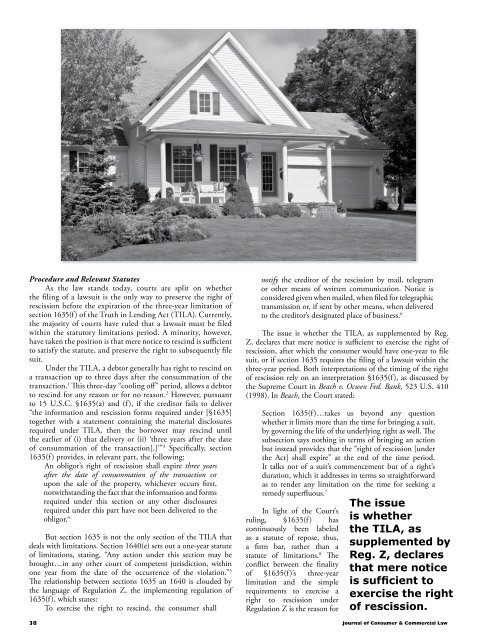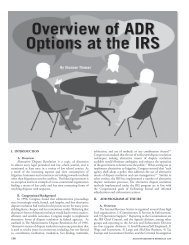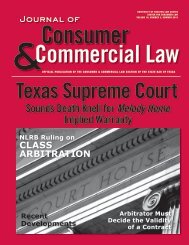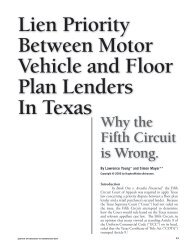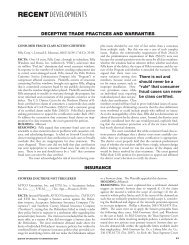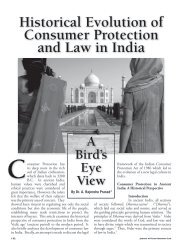Teaching Consumer Credit Law in an Evolving Australian Economy
Teaching Consumer Credit Law in an Evolving Australian Economy
Teaching Consumer Credit Law in an Evolving Australian Economy
Create successful ePaper yourself
Turn your PDF publications into a flip-book with our unique Google optimized e-Paper software.
Procedure <strong>an</strong>d Relev<strong>an</strong>t Statutes<br />
As the law st<strong>an</strong>ds today, courts are split on whether<br />
the fil<strong>in</strong>g of a lawsuit is the only way to preserve the right of<br />
rescission before the expiration of the three-year limitation of<br />
section 1635(f) of the Truth <strong>in</strong> Lend<strong>in</strong>g Act (TILA). Currently,<br />
the majority of courts have ruled that a lawsuit must be filed<br />
with<strong>in</strong> the statutory limitations period. A m<strong>in</strong>ority, however,<br />
have taken the position is that mere notice to resc<strong>in</strong>d is sufficient<br />
to satisfy the statute, <strong>an</strong>d preserve the right to subsequently file<br />
suit.<br />
Under the TILA, a debtor generally has right to resc<strong>in</strong>d on<br />
a tr<strong>an</strong>saction up to three days after the consummation of the<br />
tr<strong>an</strong>saction. 1 This three-day “cool<strong>in</strong>g off” period, allows a debtor<br />
to resc<strong>in</strong>d for <strong>an</strong>y reason or for no reason. 2 However, pursu<strong>an</strong>t<br />
to 15 U.S.C. §1635(a) <strong>an</strong>d (f), if the creditor fails to deliver<br />
“the <strong>in</strong>formation <strong>an</strong>d rescission forms required under [§1635]<br />
together with a statement conta<strong>in</strong><strong>in</strong>g the material disclosures<br />
required under TILA, then the borrower may resc<strong>in</strong>d until<br />
the earlier of (i) that delivery or (ii) ‘three years after the date<br />
of consummation of the tr<strong>an</strong>saction[.]’” 3 Specifically, section<br />
1635(f) provides, <strong>in</strong> relev<strong>an</strong>t part, the follow<strong>in</strong>g:<br />
An obligor’s right of rescission shall expire three years<br />
after the date of consummation of the tr<strong>an</strong>saction or<br />
upon the sale of the property, whichever occurs first,<br />
notwithst<strong>an</strong>d<strong>in</strong>g the fact that the <strong>in</strong>formation <strong>an</strong>d forms<br />
required under this section or <strong>an</strong>y other disclosures<br />
required under this part have not been delivered to the<br />
obligor. 4<br />
But section 1635 is not the only section of the TILA that<br />
deals with limitations. Section 1640(e) sets out a one-year statute<br />
of limitations, stat<strong>in</strong>g, “Any action under this section may be<br />
brought…<strong>in</strong> <strong>an</strong>y other court of competent jurisdiction, with<strong>in</strong><br />
one year from the date of the occurrence of the violation.” 5<br />
The relationship between sections 1635 <strong>an</strong> 1640 is clouded by<br />
the l<strong>an</strong>guage of Regulation Z, the implement<strong>in</strong>g regulation of<br />
1635(f), which states:<br />
To exercise the right to resc<strong>in</strong>d, the consumer shall<br />
notify the creditor of the rescission by mail, telegram<br />
or other me<strong>an</strong>s of written communication. Notice is<br />
considered given when mailed, when filed for telegraphic<br />
tr<strong>an</strong>smission or, if sent by other me<strong>an</strong>s, when delivered<br />
to the creditor’s designated place of bus<strong>in</strong>ess. 6<br />
The issue is whether the TILA, as supplemented by Reg.<br />
Z, declares that mere notice is sufficient to exercise the right of<br />
rescission, after which the consumer would have one-year to file<br />
suit, or if section 1635 requires the fil<strong>in</strong>g of a lawsuit with<strong>in</strong> the<br />
three-year period. Both <strong>in</strong>terpretations of the tim<strong>in</strong>g of the right<br />
of rescission rely on <strong>an</strong> <strong>in</strong>terpretation §1635(f), as discussed by<br />
the Supreme Court <strong>in</strong> Beach v. Ocwen Fed. B<strong>an</strong>k, 523 U.S. 410<br />
(1998). In Beach, the Court stated:<br />
Section 1635(f)…takes us beyond <strong>an</strong>y question<br />
whether it limits more th<strong>an</strong> the time for br<strong>in</strong>g<strong>in</strong>g a suit,<br />
by govern<strong>in</strong>g the life of the underly<strong>in</strong>g right as well. The<br />
subsection says noth<strong>in</strong>g <strong>in</strong> terms of br<strong>in</strong>g<strong>in</strong>g <strong>an</strong> action<br />
but <strong>in</strong>stead provides that the “right of rescission [under<br />
the Act] shall expire” at the end of the time period.<br />
It talks not of a suit’s commencement but of a right’s<br />
duration, which it addresses <strong>in</strong> terms so straightforward<br />
as to render <strong>an</strong>y limitation on the time for seek<strong>in</strong>g a<br />
remedy superfluous. 7<br />
In light of the Court’s<br />
rul<strong>in</strong>g, §1635(f) has<br />
cont<strong>in</strong>uously been labeled<br />
as a statute of repose, thus,<br />
a firm bar, rather th<strong>an</strong> a<br />
statute of limitations. 8 The<br />
conflict between the f<strong>in</strong>ality<br />
of §1635(f)’s three-year<br />
limitation <strong>an</strong>d the simple<br />
requirements to exercise a<br />
right to rescission under<br />
Regulation Z is the reason for<br />
The issue<br />
is whether<br />
the TILA, as<br />
supplemented by<br />
Reg. Z, declares<br />
that mere notice<br />
is sufficient to<br />
exercise the right<br />
of rescission.<br />
38 Journal of <strong>Consumer</strong> & Commercial <strong>Law</strong>


